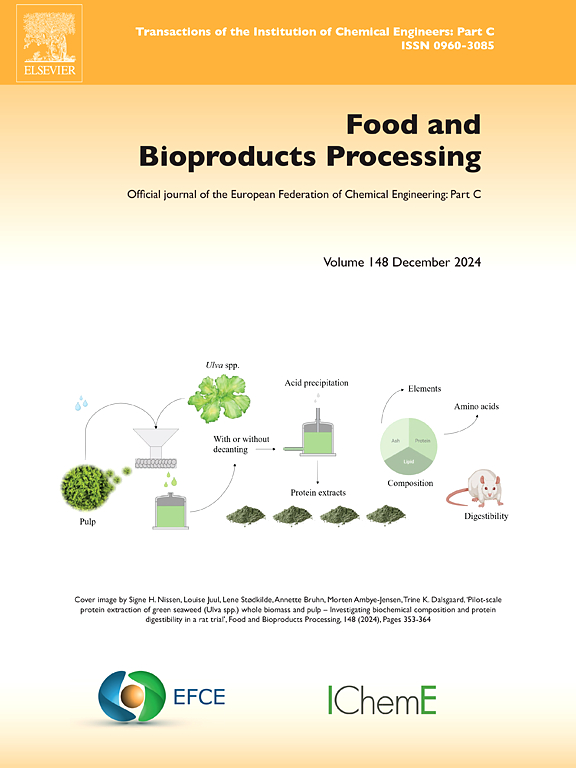蜂蜜经高压、超声和高温处理后贮藏过程中的结晶和抗生素残留
IF 3.4
2区 农林科学
Q2 BIOTECHNOLOGY & APPLIED MICROBIOLOGY
引用次数: 0
摘要
结晶和抗生素残留都是蜂蜜感知质量的破坏因素。贮藏条件影响蜂蜜的结晶速率和抗生素残留的持久性。本研究的重点是研究加标蜂蜜在25 &条件下储存180天的结晶速率和磺胺噻唑和盐酸四环素残留的减少情况。−20°C),高静水压力处理后。将该处理与未经处理、超声处理(50 kHz, 200 W, 2 h)和在相同储存条件下加入磺胺噻唑和盐酸四环素的热处理(63°C, 30 min)蜂蜜样品进行比较。测量在3个时间点进行(30,90 &;180天)。在工业装置中进行压力处理(580 MPa, 6 min, 25°C)。经过压力处理的样品在储存过程中晶体的百分比增加。在贮藏期(180天,25°C)结束时,压力处理蜂蜜的结晶率为44.83 %,显著(p <; 0.05)高于未处理蜂蜜的相应百分比(35.77 %)。对于这两种抗生素,压力导致储存期间残留物的减少,而在大多数情况下,它记录的抗生素半衰期值低于其他两种处理。与未加工的蜂蜜相比,经过压力处理的蜂蜜的半衰期也显著降低。在25°C下,未经加工的蜂蜜中的盐酸四环素半衰期为223天,比压力处理的蜂蜜的半衰期(62天)高出3倍多。未经加工的蜂蜜中磺胺噻唑的半衰期为281天,几乎是压力处理的蜂蜜(106天)的三倍。综上所述,高静水压力处理是一种很有前途的减少蜂蜜储存过程中残留物的处理方法。但是,应考虑加速结晶。本文章由计算机程序翻译,如有差异,请以英文原文为准。
Crystallization and antibiotic residues in honey during storage after treatment with high hydrostatic pressure, ultrasound and heat
Crystallization and antibiotic residues are both damaging factors for the perceived quality of honey. The storage conditions affect the crystallization rate of the honey and the persistence of antibiotic residues. This research focuses on investigating the crystallization rate and the reduction of sulfathiazole and tetracycline hydrochloride residues in spiked honey during storage (180 days at 25 & −20 °C) after high hydrostatic pressure processing. This treatment was compared to untreated, ultrasound-treated (50 kHz, 200 W, 2 h), and heat-treated (63 °C, 30 min) honey samples spiked with sulfathiazole and tetracycline hydrochloride under identical storage conditions. Measurements were conducted at 3 time points (30, 90 & 180 days). Pressure treatment (580 MPa, 6 min, 25 °C) was carried out in an industrial facility. The percentage of crystals during storage was increased for the pressure-treated samples. At the end of the storage period (180 days, 25 °C) the percentage of crystals in pressure treated honey was 44.83 %, significantly (p < 0.05) higher than the corresponding percentage for unprocessed honey (35.77 %). For both antibiotics, pressure led to an increased reduction of residues during storage, while in most cases it recorded lower half-life values of antibiotics than the other two treatments. Pressure-treated honey also recorded significantly lower half-life values compared to unprocessed honey. At 25 °C, the half-life of tetracycline hydrochloride in the unprocessed honey was 223 days, more than three times higher than the half-life in pressure-treated honey (62 days). The half-life of sulfathiazole in unprocessed honey was 281 days, almost three times higher than that in pressure-treated honey (106 days). In conclusion, high hydrostatic pressure processing is a promising treatment for reducing residues during honey storage. However, the acceleration of crystallization should be considered.
求助全文
通过发布文献求助,成功后即可免费获取论文全文。
去求助
来源期刊

Food and Bioproducts Processing
工程技术-工程:化工
CiteScore
9.70
自引率
4.30%
发文量
115
审稿时长
24 days
期刊介绍:
Official Journal of the European Federation of Chemical Engineering:
Part C
FBP aims to be the principal international journal for publication of high quality, original papers in the branches of engineering and science dedicated to the safe processing of biological products. It is the only journal to exploit the synergy between biotechnology, bioprocessing and food engineering.
Papers showing how research results can be used in engineering design, and accounts of experimental or theoretical research work bringing new perspectives to established principles, highlighting unsolved problems or indicating directions for future research, are particularly welcome. Contributions that deal with new developments in equipment or processes and that can be given quantitative expression are encouraged. The journal is especially interested in papers that extend the boundaries of food and bioproducts processing.
The journal has a strong emphasis on the interface between engineering and food or bioproducts. Papers that are not likely to be published are those:
• Primarily concerned with food formulation
• That use experimental design techniques to obtain response surfaces but gain little insight from them
• That are empirical and ignore established mechanistic models, e.g., empirical drying curves
• That are primarily concerned about sensory evaluation and colour
• Concern the extraction, encapsulation and/or antioxidant activity of a specific biological material without providing insight that could be applied to a similar but different material,
• Containing only chemical analyses of biological materials.
 求助内容:
求助内容: 应助结果提醒方式:
应助结果提醒方式:


